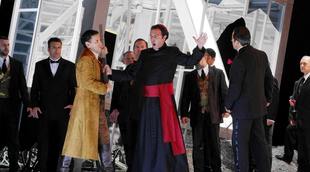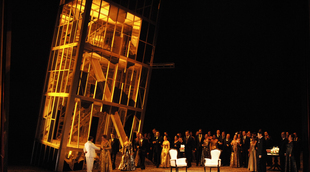 © DR
© DR
The main attraction of this Lucia di Lammermoor presented at Liceu, with 14 performances lasting until after Christmas, was the world’s debut of Juan Diego Flórez as Edgardo, one of the greatest bel canto roles, which the celebrated Peruvian tenor had not yet tackled.
Nowadays, this opera is considered a “soprano opera”, but it has not always been this way. Since its premiere in 1835, with the great Gilbert Duprez in the main male character, and until the late 19th century, Lucia di Lammermoor had been considered a “tenor opera”. Its fame was so great that the audience of the time divided the singers in the role of Edgardo into two categories, depending on which of the two greatest scenes of the role they succeeded the most in. The model for those “della maledizione” was Gaetano Fraschini (1816 – 1887) and the paradigm for those “di bella morte” was Napoleone Moriani (1808 – 1878).

Juan Diego Flórez is definitely a “di bella morte” tenor. In his take on the maledizione scene he performed only discreetly, whereas the long final scene from “Tombe degli avi miei, … Fra poco a me ricovero” until the agonic “Tu che a dio spiegasti l’ali” was an apotheosis, an exhibition of resources with easy, bright and well timbred high notes, an exquisite melodic line, an elegant phrasing and a genuine bel canto expression.
However, dying beautifully is not enough to deliver a historic Edgardo, which everyone expected from Juan Diego Flórez. The singer still has a voice that is too clear and light for a role that demands some more vocal weight. He was always correct but in the concertanti his voice did not come out and in the famous sextet he literally vanished, leaving the others to the work. Flórez is destined to go down in history as one of the greatest tenors of the 21st century, but if his voice does not change it is difficult that he will ever feature a memorable Edgardo.
Lucia, one of the legendary characters of the bel canto repertoire was entrusted to a specialist veteran of this role, Elena Moşuc. The Romanian soprano possesses every single one of the tricky and risky notes of the role, she knows the style and is brave and reliable. She participated actively in the collective passages and delivered the famous “mad scene” in a high level. Despite this, her Lucia did not seduce and was lacking the touch of subtlety that makes the difference between a very good interpretation – which she offered – and a sublime one.
The stentorian and “shouted” Enrico by baritone Marco Caria was very uninteresting, whereas Simon Orfila’s Raimondo was significantly successful. He seemed short of lower notes but was confident and powerful in his aria in the third act “Dalle stanze, ove Lucia”, which the audience long applauded, although being a secondary character that generally passes unfairly unnoticed.
Albert Casals solved with strength but without brilliance the role of Lord Arturo Bucklaw, popularly named – not without malice – “lo sposino”, one of the most unrewarding characters in the repertoire. Nothing especially interesting in the remaining secondary roles.

The choir performed well, although not so much in its first intervention, similarly as in Nabucco and Benvenuto Cellini, the previous titles of the season. The orchestra, in this occasion conferred to the hands of Marco Armiliato, fulfilled the task but did not exhibit the sound refinement that it had achieved in the previous titles. The conductor imposed some excessively slow tempi at points.
The production, coming from the Zurich Opera, turned out as a disappointment. The scene focused in an omnipresent and monumental modern tower in ruins, symbolising both the unstable mental state of the main character and the conflict developed in the plot. It had very unimpressive visual attractive and a few dramatic incongruities: to substitute the romantic fountain in the park with a boring bucket did not seem like a great idea.
The worst, however, was the deplorable acting direction, especially in the choir, wandering around the stage without a clear purpose. Damiano Michieletto, the stage director, presented at the end of Liceu’s last season a Così fan tutte that was arguable in the domain of the dramatic concept, but that was really elaborated theatrically. If he had a clear direction for this Lucia he did not succeed in conveying it effectively.
Xavier Pujol
Lucia di Lammermoor by Gaetano Donizetti | Gran Teatre del Liceu. Barcelona, 4th December.
the 09 of December, 2015 | Print
Comments